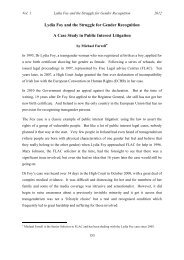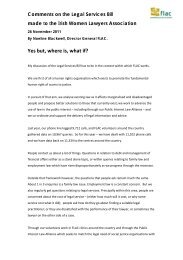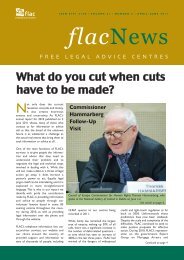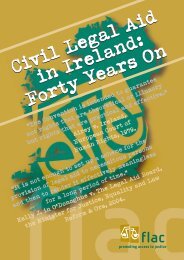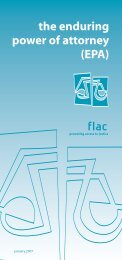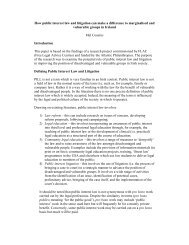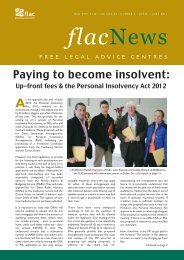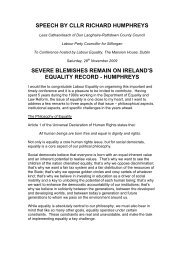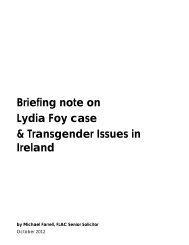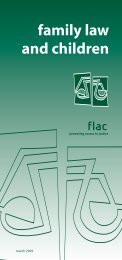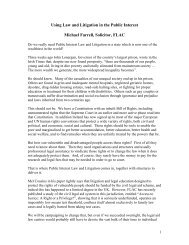Public Interest Litigation as a Tool for Vulnerable Groups: Lessons ...
Public Interest Litigation as a Tool for Vulnerable Groups: Lessons ...
Public Interest Litigation as a Tool for Vulnerable Groups: Lessons ...
Create successful ePaper yourself
Turn your PDF publications into a flip-book with our unique Google optimized e-Paper software.
considered in Maharishi Avadesh v Union of India, 37 where a petition seekinga writ of mandamus against the Government <strong>for</strong> the introduction of acommon civil code w<strong>as</strong> dismissed on the grounds that this w<strong>as</strong> an issue <strong>for</strong>the legislature and the court had no mandate in such matters. 38 A similar limitin the courts’ ambit w<strong>as</strong> revealed in dismissing a petition seeking to strikedown section 10 of the Indian Divorce Act 1869 (applicable to Christians)which it w<strong>as</strong> claimed, discriminated between men and women. 39An authoritative pronouncement on the issue w<strong>as</strong> made in Pannalal BansilalPatil v State of Andhra Pradesh 40 where the Court stated that while a uni<strong>for</strong>mcivil code <strong>for</strong> all of India may be desirable, its enactment may becounterproductive to national unity. 41 Mindful of ‘pluralist’ nature of Indiansociety, and the diversity in faith, belief systems and language, the Courtwarned:In a democracy governed by the rule of law, gradual progressive changeand order should be brought about. Making law or amendment to a law is <strong>as</strong>low process and the legislature attempts to remedy where the need is feltmost acute. It would, there<strong>for</strong>e, be inexpedient and incorrect to think that alllaws have to be made uni<strong>for</strong>mly applicable to all peoples in one go. Themischief of defect which is most acute can be remedied by process of law atstages. 42III. Specific Features that Contributed to Development of PIL in IndiaThe Indian example is a particularly appropriate one in the Irish context <strong>for</strong> anumber of re<strong>as</strong>ons: (1) India is a common law country whose legal systembears close resemblance to the Irish legal system (2) Like Ireland, India w<strong>as</strong> acolony of Britain and to that extent, the similarities in its institutions stems fromthat commonality. (3) India provides an apt comparison to Ireland since theIndian Constitution h<strong>as</strong> been influenced by the Irish Constitution and containsprovisions such <strong>as</strong> the dual language issue and the notion of directiveprinciples borrowed from the Irish Constitution.The enormity of the t<strong>as</strong>k facing the creation of a Constitution in India w<strong>as</strong>effectively captured in the words of Dr. B.R. Ambedkar the chief architect ofthe Indian Constitution:On the 26th of January 1950, we are going to enter into a life ofcontradictions. In politics we will have equality and in social and economic lifewe will have inequality. In politics we will be recognizing the principle of oneman one vote and one vote one value. In our social and economic life, weshall, by re<strong>as</strong>on of our social and economic structure, continue to deny the37 (1994) 1 Supp SCC 713.38 The petition also requested an order nullifying the Muslim Women’s Protection of Rights on DivorceAct 1986, also declined, <strong>as</strong> w<strong>as</strong> the request to direct the Government not to enact a Shariat Act, on thegrounds that it would affect the rights of Muslim women.39 Reynold Rajamani v Union of India, AIR 1982 SC 1261, 1263, 1264.40 AIR 1996 SC 1023 para.12.41 The context of that particular c<strong>as</strong>e w<strong>as</strong> <strong>for</strong> the extension of the Andhra Pradesh Hindu Religious andCharitable Endowments Act, 1987 to persons professing a variety of religions rather than it beingapplicable solely to Hindus. As cited in Bakshi (n 84 above) 89.42 Pannalal Bansilal v State of Andhra Pradesh, AIR 1996 SCW 507, 515: (1996) 2 SCC 4988



